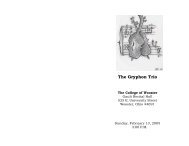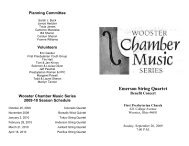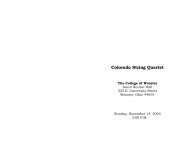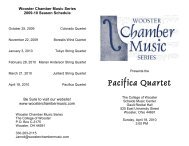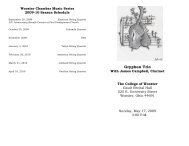Borealis Wind Quintet - Wooster Chamber Music Series
Borealis Wind Quintet - Wooster Chamber Music Series
Borealis Wind Quintet - Wooster Chamber Music Series
Create successful ePaper yourself
Turn your PDF publications into a flip-book with our unique Google optimized e-Paper software.
Beach made her professional debut in Boston in 1883, playing Chopin’s<br />
Rondo in E-flat and Moscheles’s G minor Concerto; shortly after she<br />
appeared as a soloist with the Boston Symphony Opera] Her first major<br />
success was the Mass in E-flat major, which was performed in 1892 by<br />
the Handel and Haydn Society. The well-received performance of the<br />
Mass moved Beach into the rank of America’s foremost composers. Mrs.<br />
Beach composed works in many genres, including a Mass, a symphony,<br />
a piano concerto, and works for chamber ensembles, piano, mixed<br />
chorus, and solo voice.<br />
<strong>Quintet</strong><br />
Endre Szérvanszky<br />
Endre Szervánszky was a Hungarian composer. He played clarinet as a<br />
child, and attended the Franz Liszt Academy of <strong>Music</strong> from 1922-1927.<br />
After spending several years performing professionally, he returned to<br />
study composition at the Academy in 1931 under Albert Siklós.<br />
Szervánszky orchestrated works for Hungarian Radio in the 1930s and<br />
taught at the National Conservatory from 1942 to 1948. Later he served<br />
as a member of the composition faculty at the Liszt Academy.<br />
The <strong>Wind</strong> <strong>Quintet</strong> was one of the first of its kind and evokes a rustic<br />
musical landscape with melodies and harmonies inspired by Hungarian<br />
folk music. Szervánszky’s melodic writing is characterized by an accented<br />
short note on the beat, mimicking the stressed initial syllable in spoken<br />
Hungarian; a device common in music based on traditional Hungarian<br />
sources. Though he quotes no actual folk tunes, Szervánszky uses<br />
distinctive melodies, characteristic metric formulations, and driving<br />
rhythms to reinvent the music of the countryside on the concert stage.<br />
Vergnugungszug, Op. 281<br />
Johann Strauss, Jr.<br />
Egyptian March, Op. 335<br />
Perpetual Motion, Op. 257<br />
Johann Strauss II was an Austrian composer of light music, particularly<br />
dance music and operettas. He composed over 500 waltzes, polkas,<br />
quadrilles, and other types of dance music, as well as several operettas<br />
and a ballet. In his lifetime, he was known as "The Waltz King", and was<br />
largely responsible for the popularity of the waltz in Vienna during the<br />
19th century.<br />
<strong>Borealis</strong> <strong>Wind</strong> <strong>Quintet</strong><br />
Katherine Fink, Flute<br />
Tamar Beach Wells, Oboe<br />
Kathryn Taylor, Clarinet<br />
Dan Culpepper, French Horn<br />
Wayne Hileman, Bassoon<br />
PROGRAM<br />
<strong>Quintet</strong> George Onslow (1784-1853)<br />
Allegro non troppo<br />
Scherzo, Energico<br />
Andante, Andante sostenuto<br />
Finale, Allegro spiritoso<br />
Variations sur un thème libre, Op. 42 Eugène Bozza (1905-1991)<br />
INTERMISSION<br />
Pastorale Mrs. H.H.A. Beach. (1867-1944)<br />
<strong>Quintet</strong> Endre Szérvanszky (1911-1977)<br />
Adagio. Allegro Moderato<br />
Allegro scherzoso<br />
Andante<br />
Allegro Vivace<br />
Vergnugungszug, Op. 281 Johann Strauss, Jr. (1825-1899)<br />
Egyptian March, Op. 335<br />
Arr. Friedrich Gabler<br />
Perpetual Motion, Op. 257<br />
- Jarrod Hartzler



